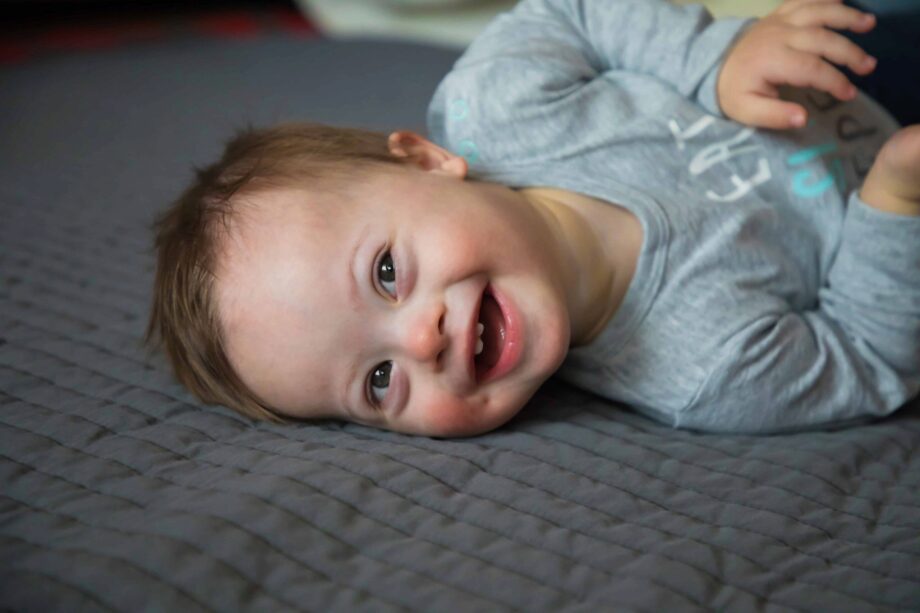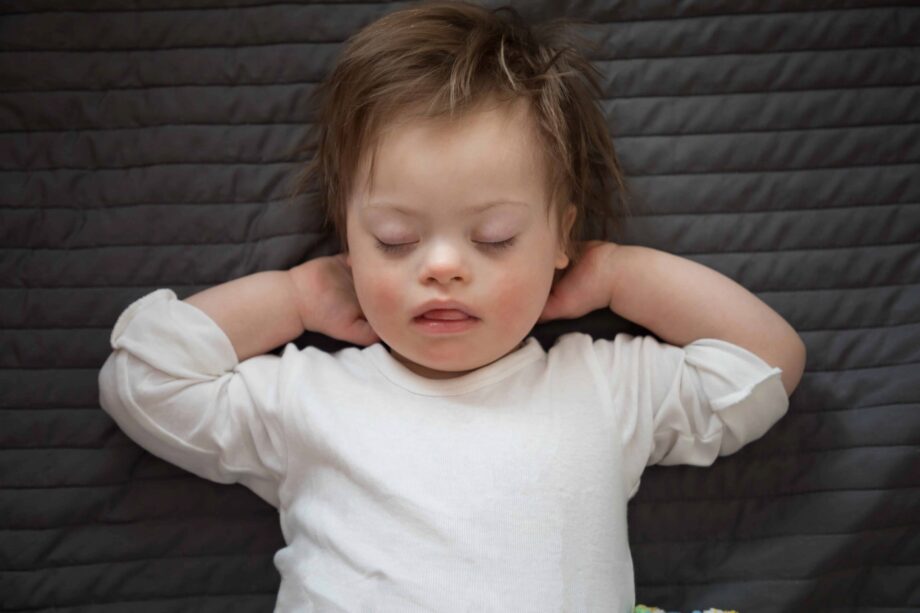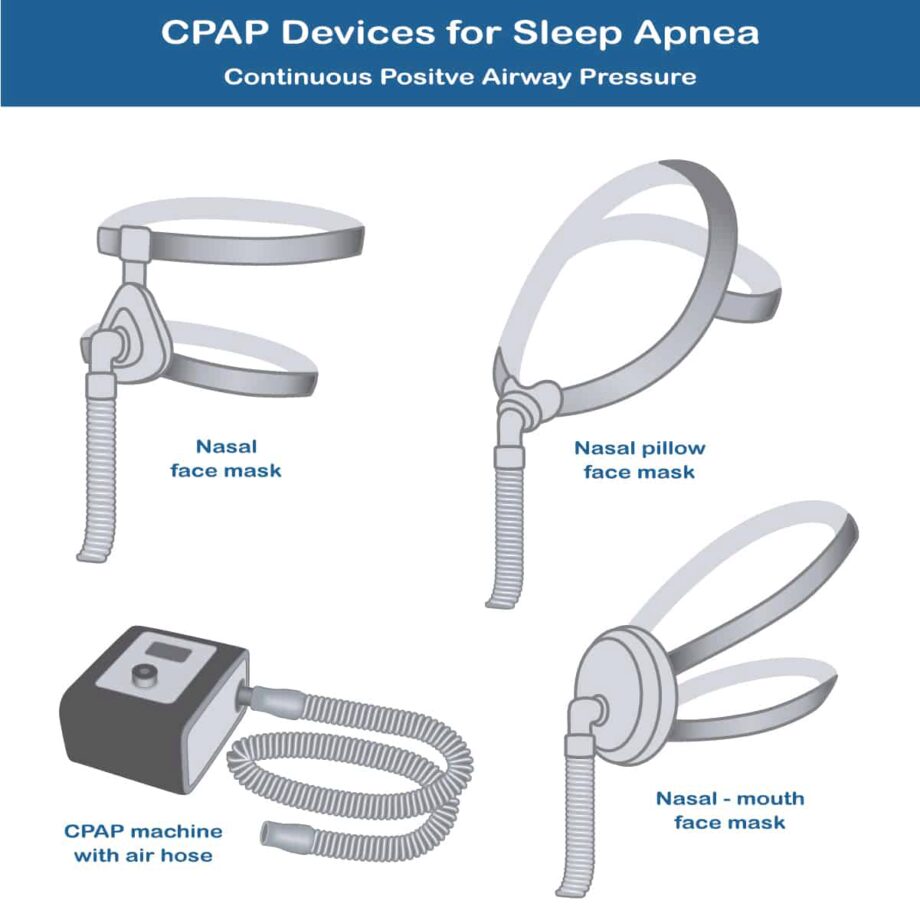Sleep and Down Syndrome
Disclosure: By clicking on the product links in this article, Mattress Nerd may receive a commission fee at no cost to you, the reader. Read full disclosure statement.

Down syndrome is the most common chromosomal disorder diagnosed in the United States, affecting about 6,000 babies born each year, according to the Centers for Disease Control and Prevention (CDC).
It is an incurable, genetic disorder that occurs when an extra chromosome develops while a fetus is forming and growing inside the womb. Chromosomes are small packages of genes in the body. Typically, babies are born with 46 chromosomes. People with Down syndrome have an extra copy of chromosome 21. Sometimes Down syndrome is referred to as Trisomy 21.
This extra chromosome affects how a baby’s body and brain develop and can result in mental and physical problems. Babies born with Down syndrome usually have developmental delays. Common physical features of Down syndrome include:
- Flattened face
- Almond-shaped eyes
- Shorter neck
- Smaller hands and feet
- Poor muscle tone
- Tongue that tends to stick out of the mouth
Children and adults with Down syndrome are at greater risk for hearing loss, eye diseases, and heart defects. They also face unique challenges when it comes to sleep, including sleep disorders like obstructive sleep apnea and insomnia. Despite these challenges, there are strategies that can help people with Down syndrome — and their loved ones — get a good night’s sleep.
Common Sleep Challenges
People with Down syndrome face a variety of challenges when it comes to sleep. “Children with Down syndrome have problems sleeping mostly because of breathing and behavioral problems,” says Dr. Chris Norris, Certified Sleep Science Coach and founder at SleepStandards.com. “It’s the same for adults with that condition, however, adults can also suffer from insomnia and psychological sleep problems.”
Parents and caregivers of children with Down syndrome also face sleep deficits as they are often called on during their night to help soothe their loved one.
What is Dyssomnia?
According to the National Institute of Health (NIH), 76% of children with Down syndrome sleep poorly, have more fragmented sleep, and wake frequently compared to typical children. These sleep problems often persist with these children into adulthood, and are often categorized as dyssomnia sleep disorders.
Dyssomnia is a primary sleep disorder that causes trouble falling asleep or staying asleep. Dyssomnia is divided into different categories — intrinsic, extrinsic and circadian.
- Intrinsic sleep disorders originate or develop from causes within the body. Some examples of intrinsic sleep disorders include idiopathic and psychophysiological insomnia, narcolepsy, obstructive sleep apnea, periodic limb movement disorder, and restless leg syndrome.
- Extrinsic sleep disorders are caused by external factors, such as food allergies, poor sleep hygiene, environmental issues, nocturnal eating, alcohol dependence, and altitude.
- Circadian rhythm sleep disorders occur when the integral sleep-wake rhythm and light dark cycle become desynchronized. This leads to insomnia and/or excessive daytime sleepiness.
Two of the most common types of dyssomnia sleep disorders individuals with Down syndrome experience are obstructive sleep apnea and insomnia.

Obstructive Sleep Apnea
Obstructive sleep apnea (OSA) is a sleep disorder that occurs when breathing is briefly and repeatedly interrupted during sleep. It occurs when the muscles in the back of the throat close, forcing the sleeper awake to catch his breath. It can cause fragmented sleep and excessive daytime sleepiness.
Between 35-42% of adults with Down syndrome suffer from obstructive sleep apnea — about 10 times that of the general population, according to a study published in the journal Breathe. Babies with Down syndrome are also at risk of having OSA compared to the general population, according to a study by NIH, which found 31% of babies with Down syndrome also have obstructive sleep apnea. Researchers believe this is due to physical abnormalities associated with the condition such as narrow upper airways, larger tongues and tonsils, looser muscle tone, and a propensity for being overweight.
OSA can cause low blood oxygen and, when combined with fragmented sleep, can lead to other health conditions, such as:
- Chronic fatigue
- Heart disease
- High blood pressure
- Insulin resistance
- Type 2 diabetes
- Memory problems
Insomnia
Insomnia is characterized by an inability to fall asleep or stay asleep. It is the most common sleep disorder affecting about a quarter of the general population, according to a recent University of Pennsylvania School of Medicine study. Children with Down syndrome are more prone to insomnia, according to an NIH study which found three quarters of children with Down syndrome had trouble falling asleep at night and staying asleep throughout the night. The problem often lingers with these children into adulthood.
Insomnia is often categorized as primary or secondary.
- Primary insomnia is not directly linked to any health causes, though there may be environmental or behavioral triggers.
- Secondary insomnia is caused by a mental or physical health condition, such as anxiety, asthma, or pain; or a substance like medication or alcohol.
There are several causes for insomnia in the general population that may be more pronounced in children and adults with Down syndrome:
- Anxiety: Anxiety can affect anyone, and when it does, it often disrupts sleep. Adults and children with Down syndrome are more prone to experience anxiety and other mental health conditions. This is likely due to limitations in language and communication skills, cognition, and nonverbal problem solving abilities.
- Stress: Anyone can experience insomnia due to stress, and this is especially true for people with Down syndrome. According to the National Down Syndrome Society, at least half of all adults and children with Down syndrome experience a major medical issue in their lives which, in turn, creates stress.
- Restlessness/inability to settle down: Mental and physical health challenges individuals with Down syndrome face can contribute to their inability to settle down at night for a good night’s sleep.
- For children specifically:
- Difficulty sleeping alone: Children with underlying anxiety often fear being alone at night and want to cosleep with either a parent or sibling. While this may help the child rest better, it can disrupt the sleep of the person they’re sleeping with. Plus, it sets up a bad sleeping habit that is hard to break.
- Bedwetting: Many young children are awakened when they wet the bed. Children with Down syndrome have developmental delays. Thus, they can take longer to potty train and longer to overcome bedwetting at night.
Related: Best Mattress for Kids

How to Get a Better Night’s Rest
Sleep Hygiene
One way to improve sleep is by adopting good sleep habits, also known as improving your sleep hygiene. This involves changing some environmental and behavioral sleep factors surrounding your sleep.
“Most sleep issues can be improved by developing good sleep hygiene such as setting a routine at bedtime, following a regular sleeping hour, and having a bedroom that’s free from distractions,” says Dr. Norris. “Avoiding exercise, caffeinated drinks, and other stimulants at night would also help.”
- Nighttime routine: Most parents can see the value of establishing a bedtime routine for their kids about 30 minutes before bedtime. It helps kids wind down so they can fall asleep easier. Adults can benefit from a nighttime routine as well. Some good bedtime rituals for anyone include:
- Taking a warm bath
- Listening to soothing music
- Meditating
- Reading a book. Anything that will tell your mind and body that it’s time for bed.
- New mattress: An old, sagging mattress can disrupt your sleep and leave you feeling worn out the next morning. A new mattress made of memory foam or latex can provide cushioning comfort with enough support to keep you comfortable all night long.
- Eye mask: Artificial light and even early morning sunlight can trick your mind into thinking it’s time to be awake and alert. Try sleeping in a comfortable eye mask to block out unwanted light.
- Comfortable, breathable PJs: Tight, constrictive clothing hinders sleep. Be sure your jammies are soft and breathable so you can stay cool and comfortable all night long.
- White noise machine: Not only does white noise help block out noise inside and outside your house, it can also help lull you to sleep.
- Avoiding blue light too close to bed: Blue light emanates from television screens, mobile phones, and electronic tablets. It’s great during the day because it helps keep you alert. But too much screen time before bedtime can make it difficult to fall asleep.
- Room temperature: It is recommended, for optimal sleep, that room temperature be set between 60 to 67 degrees, experts say.
- Avoiding strenuous exercise too close to bed: Exercise is great for working out daytime stress. But too much exercise too close to bedtime can hinder sleep because the endorphins it releases act more to energize you than to lull you to sleep.
- Avoiding stimulants before bedtime: Caffeine and nicotine are stimulants and can keep you from falling asleep if taken too late in the day. Alcohol, on the other hand, can help you fall asleep. But if you have too many drinks before bedtime, you’ll end up waking during the night and have difficulty falling back to sleep.
Ideal Sleeping Positions
If you suspect your loved one has sleep apnea, you’ll need to get a formal diagnosis from a doctor or sleep specialist. Non-medical treatment may be recommended such as raising the head of the bed with pillows or by using an adjustable bed.
Changing sleep position may also help. People with sleep apnea should avoid sleeping on their backs because doing so enables gravity to allow the tissues in the mouth to fall to the back of the throat. This can obstruct the airway leading to episodes of apneas (temporary cessation of breathing and hypopneas (abnormally slow or shallow breathing). Side sleeping is the preferred position for people with sleep apnea because it helps keep the airway open.
One common treatment for sleep apnea is a CPAP machine, short for Continuous Positive Airway Pressure. These machines gently blow pressurized air through the nose at a pressure high enough to keep the throat and airway open. While these machines are usually used by adults, some CPAP machines are specifically designed for children.
CPAP machines can be intimidating even for adult users. Here are some tips to help your child adjust to using CPAP:
- Wait until your child is in a good mood and then allow them practice using the device first.
- Let your child touch the mask, the hose, and the machine it’s hooked up to, and listen to the noises it makes.
- Place the mask on a stuffed animal or doll so they can see the experience.
- Stay calm while your child is using the machine, and use a soft, reassuring voice to help them overcome any anxiety it causes.
- Praise your child for using it. Even the smallest improvements deserve recognition.

The Benefits of Exercise and Nutrition
Exercise and nutrition play an important role in helping you get a good night’s sleep. Here are some ways you can improve both.
Regular exercise. Even as little as 10 minutes of exercise a day has been shown to help you fall asleep and stay asleep throughout the night. Go for a jog or brisk walk, take a hike in nature, or dance to your favorite music. But, be sure not to do any vigorous workouts too close to bedtime as doing so can make falling asleep more difficult.
Relaxation exercises. One type of exercise that’s great to practice as you’re winding down before bedtime is a relaxation exercise. Taking a few minutes to relax and do some deep breathing before bedtime can help release overall tension.
Healthy diet. Some things to keep in mind:
- Avoid heavy meals before bedtime. It’s difficult to fall asleep with a bloated belly.
- Avoid spicy or acidic foods. These increase the risk of acid reflux, which can get worse at night while you’re lying in bed trying to sleep.
- Stay hydrated during the day. But try not to drink too much liquid too close to bedtime or you may wake up to take bathroom breaks.
- Avoid alcohol and caffeine too close to bedtime. Both can disrupt sleep.
Final Thoughts
Down syndrome is closely linked to sleep problems. Even caregivers of individuals with Down syndrome can suffer from insomnia, fractured sleep, and other sleep disorders. You are not alone. There are some small things you can do to help improve your sleep and the sleep of your loved one. If problems persist — or if you think you or your loved one has a sleep disorder like obstructive sleep apnea — consult a medical professional. Because, everyone deserves a good night’s sleep.


